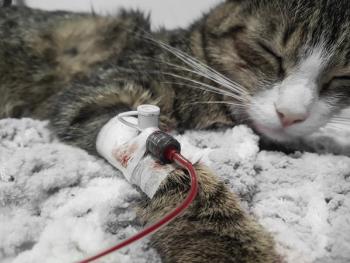
Ear flushing tips and tricks for the general practitioner

Your go-to guide for performing successful ear flushes at the clinic
This content is sponsored by Nextmune.
At the 2022 Fetch dvm360® Conference in San Diego, California, Ashley S. Bourgeois, DVM, DACVD—also known as “The Derm Vet”—shared expert advice for general practitioners on successfully flushing ears in the hospital setting.1 Some of the goals of ear flushing include relieving discomfort, removing debris, and eliminating infection. Additionally, “Flushing is not just therapeutic, but it also serves as a diagnostic,” said Bourgeois.
Before ear flushing
She noted the importance of having a variety of at least 3 to 4 ear flushes at the practice that work for you and can tailor to each patient’s needs. Before selecting the cleanser, perform swab cytology, identify which flush to use based on the infection and inflammation, and evaluate the debris. “I select my flushes based on what’s going on in that ear. If there’s a bunch of [rod-shaped bacteria] in that ear, I’m going to pick a way different flush that’s going to help me with that infection versus if it’s a bunch of Malassezia.”
Active ingredients in ear flushing products to be mindful of depending on your case include:
- Acidifying agents
- Alkalinizing agents
- Antibiotics
- Antifungals
- Anti-inflammatories
- Astringents
- Cerumenolytics
- Disinfectants
- Keratolytic agents
- Keratoplastic agents
- Parasiticides
- Soothing agents
Ear flushing: finding the proper tool
Bourgeois advised to incorporate a combination of techniques for the best result. For large debris she recommends using:
- Forceps
- Ear curette: Can scrape off debris adhered to the deep ear canal or tympanum
- Bulb syringe: Can be forceful, so take sterile saline or water, keep the bulb clean, and rinse until solution is clear
For small debris, she recommends using the red rubber feeding tubes, and noted that 8F is what is used in a handheld otoscope and 5F is used in a video otoscope (VO). These tubes can be attached to the syringe for flushing. Bourgeois is a strong proponent of using the VO as this tool improves the image and provides intense lighting so you can view the tympanum and detect better what is going on in the ear.
Getting started
To begin flushing, start with a cerumenolytic to loosen debris, flush with a sterile saline, follow up with a disinfectant, and visualize with the otoscope after cleaning.
Because tube flushing is very stimulating for pets, Bourgeois suggested to use sterile saline at room temperature, so its not as shocking for them. She added that multiple flushes are required and to use a bowl of flushing solution or ear flushing units. “The benefits of [ear flushing units] are that with the push of button you’re flushing or your sucking,” she noted. Having patients under general anesthesia is ideal to help to avoid stimulation and it protects the pharynx. However, according to Bourgeois, “In the real world, not everyone can afford to do general anesthesia every time they do an ear flush so one thing you can do to kind of help is elevate. If you have a wet table, you can put some towels under it so then at least if there is fluid that ends up in the pharynx or oral cavity, gravity will help us out a little bit.”
Some adverse effects of ear flushing can include hearing loss, vestibular signs, and Horner’s syndrome. “You want to inform owners of the [risk of developing Horner’s syndrome], usually if that happens, with time and supportive care and steroids to decrease inflammation most of [these patients] will resolve, but it’s something you want to let them know about because it’s really scary when it happens,” said Bourgeois.
Bourgeois also emphasized further educating clients on at-home ear flushing techniques as regular cleaning improves efficacy of topical antibiotics, treats active infections, and maintenance therapy is important particularly for chronic otitis cases. She advised to provide clients resources or have veterinary staff inform them for success in between veterinary visits.
Reference
Bourgeois A. Don’t forget to flush! Deciphering ear flush ingredients and selecting appropriate techniques. Presented at: Fetch dvm360® Conference; San Diego, California. December 2-4, 2022.
Newsletter
From exam room tips to practice management insights, get trusted veterinary news delivered straight to your inbox—subscribe to dvm360.




